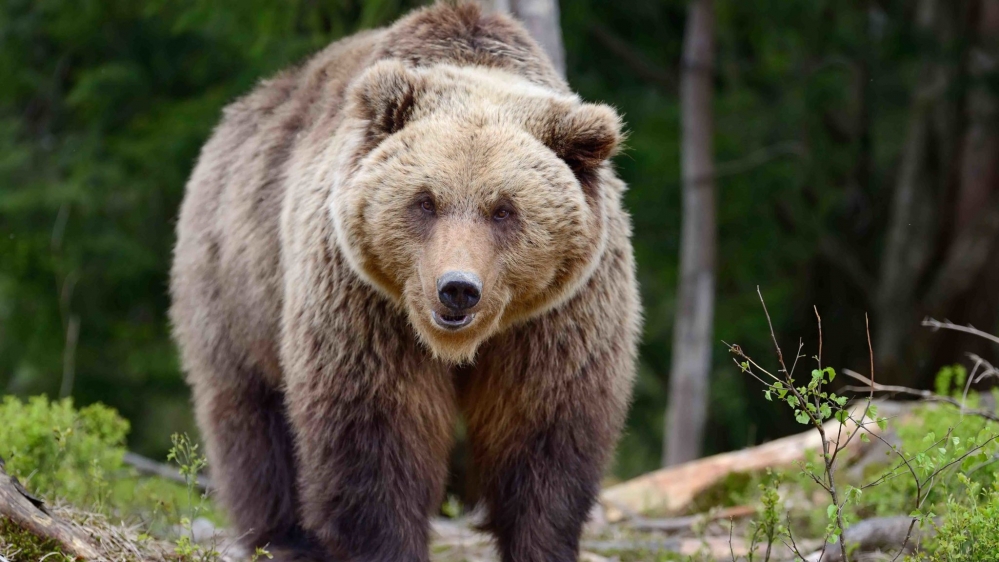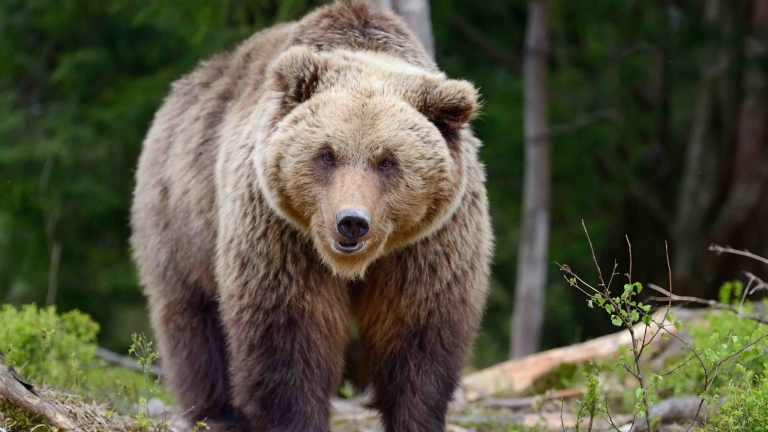The first time I met a bear in the wild was on a gorgeous afternoon, hot in the sun but fresh under the towering cedars, fir and hemlock, in Jasper National Park in western Canada. Without warning the animal came trotting out of the bush about a dozen metres from me. I froze. It was a smallish animal, a black bear not a grizzly bear, and showed no signs of aggression, nor any real interest in me at all. But to my untrained eyes it appeared far larger, a primordial beast that could only have had one purpose in seeking me out in this uninhabited corner of the Rocky Mountains.
Of course I had read the bear safety information posted at campgrounds in the area.
Never run, it might elicit pursuit. Stand still. Assess the situation. If the bear advances in your direction, hold your ground. I even knew that few bears are aggressive and the number of attacks in north America extremely small. But now this was for real. I was face-to-face with my first wilderness bear. I felt my stiff upper lip begin to quiver. The steel in my backbone began to buckle, like an old bridge succumbing to the elements. Fear came into my throat and my heart began to pound.
I glanced at my camper van parked not a dozen metres from where I was standing. And then, as everything I had ever read about bears evaporated in a haze of blind panic, I turned and sprinted for the van. The small bear trotted off into the bush. It is true that bears are powerful and remarkably quick. Over short distances a bear can match a racehorse for speed. They have greater muscle mass than we do. A bear of the same body weight is roughly three times as strong as a human. They also have exceptionally fine noses, packed with thousands of scent receptors. They have good eyes and good ears. But for all their abilities as predators, bears, are generally peaceful and risk-averse animals. They mostly keep out of our way as long as we don’t threaten their young, act aggressively, or try and steal their food. In the last 50 years, on average, just over two people a year have been killed by bears in North America. Domestic dogs, by contrast, kill hundreds annually. Statistically, you are more likely to die from a flat screen television falling on your head than you are to be killed by a bear.
My second meaningful encounter with a bear, and my first with a grizzly bear, came just a few months later. As I came around a corner in a remote valley one October afternoon the bear was sitting in the middle of a wide trail, so stuffed with apples she could barely move, under the tree she had just been feeding from. Again I froze. But this bear seemed if anything comical, certainly not menacing. She scratched and grunted and tried to raise herself awkwardly into a standing position. But after all the fruit she had eaten the effort just seemed too much for her. Eventually she slumped down again and just sat on the ground.
Over the years this bear was to become an integral part of my life. Apple, as we named her after the fruit that she so liked to gorge on, furnished me with much of my early bear knowledge.
Learning the trade took time. I read countless books, some of them written by hunter-settlers in the early 20th Century. I consulted bear experts. I went on a course about bear behaviour. And then I headed out into the forest and, over several years, I spent thousands of hours watching bears. But there was no bear I spent more time with than Apple. She was a good teacher. At times she would walk within a few metres of me without a single sign of stress. But on others, especially when she was on a kill, or felt hemmed in, she would become wilder, huffing and moving her head anxiously at the first sign of my approach. I learned to watch the position of her ears, the subtle open and closing of her mouth, and the stiffness of her body posture, all indicators of her mood and intent. Several years later Apple had two cubs. They returned to the valley where I lived each year to feed on salmon. By now I was a professional guide, earning my living taking guests out into the wilderness to view grizzly bears in their natural setting.

Photo: wildbearlodge.ca
Meanwhile Apple was becoming something of a celebrity. Her image hung in photo galleries in the nearest town. Once, thanks to a timeless photo taken by a friend, she was on the cover of the Wall Street Journal. And then, just as she was rearing her second set of cubs, she was shot by a hunter. That autumn her cubs returned alone. They were still small and looked lost and unsure of themselves. The death of Apple might have been less piercing if she had died naturally. The cycle of life, though sometimes bitter, is one that I was witnessing day in, day out. The hawks ate the songbirds, the cougars ate the deer, the wolves and cougars fed on snowshoe hare.
But to shoot her just to turn her into a trophy rug seemed such a waste. At first I was angry and bereft. But anger alone doesn’t get you anywhere.
For years I lobbied. I travelled with my wife and partner Kristin to meet the politicians that made the laws. I attended fundraisers, government policy meetings and helped make a documentary about our story and the grizzly bear hunt. The ins and outs of the struggle to end the hunt could fill an entire book. But, finally, after more than three years and countless setbacks, we had a breakthrough. A new premier of British Columbia was elected, a man who had visited our lodge and seen our operation for himself. He agreed to ban the hunting of grizzly bears in the spring of 2018.
It hasn't been an easy journey to become a bear guide. My previous job had been as an international newspaper correspondent covering mostly wars and conflict. At the beginning I had none of the skills I needed. Learning how to track animals, the intricacies of bear behaviour, and all the essentials of the wilderness - first aid, survival, white-water rafting and how to use everything from chainsaws to quad bikes - has taken me years. But now, after hundreds of hours spent on my knees studying tracks, thousands of hours spent watching bears, and nearly 15 years in the wilderness, I count among British Columbia's most experienced bear guides.
I've come along way since I first ran away from that black bear in Jasper.
Ez a cikk elérhető magyarul is.
Cover: Cowboy State Daily.










